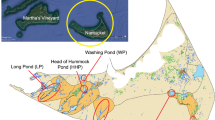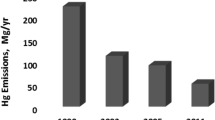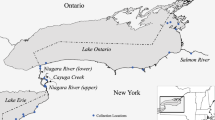Abstract
Mercury contamination in aquatic ecosystems is a concern due to health risks of consuming fish. Fish mercury concentrations are highly variable and influenced by a range of environmental factors. However, seasonal variation in mercury levels are typically overlooked when monitoring fish mercury concentrations, establishing consumption advisories, or creating accumulation models. Temporal variation in sampling could bias mercury concentration estimates of accumulation potential. Thus, the objectives of this study were to first evaluate seasonal variation of largemouth bass (Micropterus salmoides) axial muscle mercury concentration from two Iowa, USA impoundments. Second, we conducted a meta-analysis to evaluate if seasonal variation in mercury concentration is dependent upon mean mercury concentration, waterbody type, or fish trophic level or mean length. Largemouth bass were collected four times between May and October (24–36 fish per month) from Twelve Mile (2013) and Red Haw (2014) lakes. Largemouth bass axial muscle mercury concentrations were variable within and between lakes, ranging from undetectable ( < 0.05 mg/kg) to 0.54 mg/kg. Largemouth bass mercury concentrations were similar across months in Twelve Mile but varied temporally in Red Haw and were highest in July, intermediate in May and September, and lowest during October. Results of the meta-analysis suggest that seasonal variation in mercury concentrations is more likely to occur as mean mercury concentration of the population increases but is unrelated to waterbody type, trophic status, and fish size. Understanding seasonal variation in fish mercury concentrations will aid in the development of standardized sampling programs for long-term monitoring programs and fish consumption advisories.



Similar content being viewed by others
References
Bae JH, Lim SY (2012) Effect of season on heavy metal contents and chemical compositions of chub mackerel (Scomber japonicus) muscle. J Food Sci 77:52–57
Bratten HFV, Fjeld E, Rognerud S, Lund E, Larssen T (2014) Seasonal and year-to-year variation of mercury concentration in perch (Perca fluviatilis) in Boreal lakes. Envir Tox Chem 33:2661–2670
Burger J, Gochfeld M (2011) Mercury and selenium levels in 19 species of saltwater fish from New Jersey as a function of species, size, and season. Sci Total Envir 409:1418–1429
Cochran PA, Adelman IR (1982) Seasonal aspects of daily ration of largemouth bass (Micropterus salmoides), with an evaluation of gastric evacuation rate. Envir Bio Fish 7:265–275
Costa MF, Barbosa SCT, Barletta M, Dantas DV, Kehrig HA, Seixas TG, Malm O (2009) Differences in mercury accumulation in Trichiurus lepturus (Cutlassfish) in relation to length, weight and season. Envir Sci Poll Res 16:423–430
Farkas A, Salanki J, Varanka I (2000) Heavy metal concentrations in fish of Lake Balaton. Lakes Reserv: Res Manag 5:271–279
Farkas A, Salanki J, Specziar A (2003) Age- and size-specific patterns of heavy metals in the organs of freshwater fish Abramis brama L. populating a low-contaminated site. Water Res 37:959–964
Foster EP, Drake DL, DiDomenico G (2000) Seasonal changes and tissue distribution of mercury in largemouth bass (Micropterus salmoides) from Dorena Reservoir, Oregon. Arch Envir Contam Tox 38:78–82
Fowlie AR, Hodson PV, Hickey MBC (2008) Spatial and seasonal patterns of mercury concentrations in fish from the St. Lawrence River at Cornwall, Ontario: Implications for monitoring. J Gt Lakes Res 34:72–85
Gochfield M, Burger J, Jeitner C, Donio M, Pittfield T (2012) Seasonal, locational and size variations in mercury and selenium levels in striped bass (Morone saxatilis) from New Jersey. Envir Res 112:8–19
Greenfield BK, Melwani AR, Allen RM, Slotton DG, Ayers SM, Harrold KM, Ridolfi K, Jahn A, Grenier JL, Sandheinrich MB (2013) Seasonal and annual trends in forage fish mercury concentrations, San Francisco Bay. Sci Tot Envir 444:591–601
Griffiths D, Kirkwood RC (1995) Seasonal variation in growth, mortality and fat stores of roach and perch in Lough Neagh, Northern Ireland. J Fish Bio 47:537–554
Hylander LD, Pinto FN, Guimarães JRD, de Castro e Silva E (2000) Fish mercury concentration in the Alto Pantanal Brazil: Influence of season and water parameters. Sci Total Envir 261:9–20
Kailasam S, Jeyasantha KI, Giftson H, Patterson J (2015) Sexual maturity linked variations in proximate composition and mineral content of female Scomberomorus commerson (Narrow Banded Mackerel) in south east coast of India. Sky J Food Sci 4:108–115
Kenney LA, Eagles-Smith CA, Ackerman JT, von Hippel FA (2014) Temporal variation in fish mercury concentrations within lakes from the Western Aleutian Archipelago, Alaska. PLoS ONE 9:e102244. https://doi.org/10.1371/journal.pone.0102244
Laarman PW, Willford WA, Olson JR (1976) Retention of mercury in the muscle of yellow perch (Perca flavescens) and rock bass (Ambloplities rupestris). Trans Am Fish Soc 105:296–300
Lange TR, Royals HE, Connor LL (1993) Influence of water chemistry on mercury contamination in largemouth bass from Florida lakes. Trans Am Fish Soc 122:74–84
Leu S, Jhaveri SN, Karakoltsidis PA, Constantinides SW (1981) Atlantic mackerel (Scomber scombrus, L): seasonal variation in proximate composition and distribution of chemical nutrients. J Food Sci 46:1635–1638
Madenjian CP, Blanchfield PJ, Hrenchuk LE, Van Walleghem JLA (2014) Mercury elimination rates for adult northern pike Esox lucius: evidence for a sex effect. Bull Environ Contam Tox 93:144–148
Marrugo-Negrete J, Navarro-Frómeta A, Ruiz-Guzmán J (2010) Total mercury concentrations in fish from Urrá reservoir (Sinú river, Columbia). Six years of monitoring. Rev MVZ Córboda 20:4754–4765
Meili M (1991) Mercury in forest lake ecosystems – bioavailability, bioaccumulation and biomagnification. Water, Air, Soil Poll 55:131–157
Moreno CE, Fjeld E, Deshar MK, Lydersen E (2015) Seasonal variation of mercury and δ15N in fish from Lake Heddalsvatn, southern Norway. J Limn 74:21–30
Murphy GW, Newcomb TJ, Orth DJ (2007) Sexual and seasonal variations of mercury in smallmouth bass. J Fresh Ecol 22:135–143
Özden Ö,(2010) Micro, macro mineral and proximate composition of Atlantic bonito and horse mackerel: a monthly differentiation Inter J Food Sci Tech 45:578–586
Saei-Dehkordi SS, Fallah AA, Nematollahi A (2010) Arsenic and mercury in commercially valuable fish species from the Persian Gulf: Influence of season and habitat. Food Chem Toxicol 48:2945–2950
Selch TM, Hoagstrom CW, Weimer EJ, Duehr JP, Chipps SR (2007) Influence of fluctuating water level on mercury concentrations in adult walleye. Bull Environ Contam Toxicol 79:26–40
Tremain DM, Adams DH (2012) Mercury in groupers and sea basses from the Gulf of Mexico: relationships with size, age, and feeding ecology. Trans Am Fish Soc 141:1274–1286
Tugrul S, Salihoglu I, Balkas TI, Audogdu T (1980) Seasonal variation of mercury concentrations in organisms of the Cilician Basin. Envir Inter 4:281–287
[USEPA] United States Environmental Protection Agency (1998) Method 6020A inductively coupled plasma–mass spectrometry. https://www.epa.gov/sites/production/files/2015-07/documents/epa-6020a.pdf.
[USEPA] United States Environmental Protection Agency (2000) Guidance for assessing chemical contaminant data for use in fish advisories. Fish Sampling and Analysis, 3rd edn, vol 1. Office of Science and Technology and Office of Water, Washington, D.C
[USEPA] United States Environmental Protection Agency (2003) Technical standard operating procedure non-lethal fish tissue plug collection. SOP #EH-07, East Helena Site, Montana
[USEPA] United States Environmental Protection Agency (2010) Guidance for implementing the January 2001methylmercury water quality criterion. Office of Water, Washington, DC, EPA 823-R-10-001
Van Walleghem JLA, Blanchfield PJ, Hintelmann H (2007) Elimination of mercury by yellow perch. Envir Sci Tech 41:5895–5901
Ward SM, Neumann RM (1999) Seasonal variations in concentrations of mercury in axial muscle tissue of largemouth bass. N Am J Fish Manag 19:89–96
Weatherly AH, Gill HS (1987) The biology of fish growth. Academic Press, Orlando, Florida
Wiener JG, Spry DJ (1996) Toxicological significance of mercury in freshwater fish. In: Beyer W, Heinz GH, Norwood AW (eds) Environmental contaminants in wildlife: Interpreting tissue concentrations. Lewis Publishers, Boca Raton, pp. 297–339
Weis P, Weis JS, Bogden J (1986) Effects of environmental factors on release of mercury from Berry’s Creek (New Jersey). Sediments and its uptake by killifish Fundulus heteroclitus. Envir Poll 40:303–315
Acknowledgements
We thank Iowa DNR fisheries personnel throughout the state that assisted with fish collection for this project. We also thank S. Chipps for constructive comments on an earlier draft of the manuscript. Use of trade, product, or firm names is descriptive only and does not imply endorsement by the U.S. Government. This project is funded by the Iowa Department of Natural Resources through contract 14CRDFBGSCHO-0002 to Iowa State University as part of an evaluation of mercury contamination in Iowa fishes.
Author information
Authors and Affiliations
Corresponding author
Ethics declarations
Conflict of interest
The authors declare that they have no conflict of interest.
Ethical approval
All applicable international, national, and/or institutional guidelines for the care and use of animals were followed. This study was performed under the Iowa State University Institutional Animal Care and Use Committee (IACUC) protocol permit 4-14-7780-I and animals were collected under state permit SC1037.
Appendix
Rights and permissions
About this article
Cite this article
Mills, N., Cashatt, D., Weber, M.J. et al. A case study and a meta-analysis of seasonal variation in fish mercury concentrations. Ecotoxicology 27, 641–649 (2018). https://doi.org/10.1007/s10646-018-1942-4
Accepted:
Published:
Issue Date:
DOI: https://doi.org/10.1007/s10646-018-1942-4




